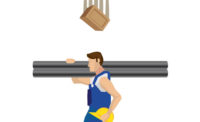Sleep is a vital part of the day and when you add in heavy machinery operation, the need is even more pronounced. Many construction crews and engineers work on-call or extend their shifts longer than eight hours. While these workers are commendable for their commitment, irregular and extensive schedules are not sustainable.
When the crew is exhausted, the workspace becomes more dangerous for everyone. Avoid potential injuries and accidents by understanding the signs of fatigue and creating a safe and comfortable schedule for all.
The problem with long work hours
Though some people might have trouble rolling out of bed in the morning, fatigue is a deeper sense of tiredness brought on by a continual lack of sleep and bodily exhaustion. Instead of yawning through morning meetings, fatigued workers can experience a degradation of wellness in their muscles, memory and mental state.
Overexertion of muscles can deteriorate long-term strength and stability. Memory also quickly diminishes without proper rest, causing poor concentration and decision-making skills. When construction or manufacturing teams are operating heavy machinery and specialized equipment, their senses need to attune in order to perform safely.
In fact, 13% of work injuries stem from poor rest and sleep schedules. Companies and managers need to address relaxation to keep construction and manufacturing sites safe for everyone.
Causes and signs of fatigue
Fighting fatigue is crucial to a safe workplace, but how can managers spot when their crew is suffering? Better yet, how can an employee self-identify when they need rest? Understanding the causes and signs of fatigue benefits all levels of the system.
Poor or interrupted sleep, changes in daily schedules, extensive work hours, intensive physical labor and extreme weather conditions can all cause fatigue. Most of these causes are external forces, battering the body with cold weather or strenuous activity, but improper sleep is an internal factor that needs attention.
Sleep is the best way for the body to recuperate and prepare for the new day. When a person is napping in short bursts, they miss out on REM sleep — or the zone in which they dream. This state of unconsciousness places the body into a type of paralysis, but the brain is rife with activity and thought. Proper REM sleep ensures rational thinking, physical fitness and better memory.
Some critical signs that you or a crew member may be experiencing fatigue are:
- Frequent signs of sleepiness: These can be signals like yawning, drifting off, headaches and heavy eyelids. If these symptoms are frequent and hard to control, the person needs to recharge fully.
- Poor memory and concentration: Trouble focusing on immediate tasks and a lack of awareness may be signs of extreme tiredness.
- Increased sickness: When the body is fighting to stay awake and complete strenuous activities, it has less energy to ward off illness. Continually ill employees could be suffering from a lack of rest.
Once you recognize the signs, it can be much easier to ward off fatigue in a long-term strategy.
Solving workplace fatigue
Ensuring a well-rested team means more productivity and a heightened sense of safety for all involved. Explore new avenues of training and scheduling to take care of your crew.
First, evaluate your staffing schedules. Many construction and manufacturing teams work inconsistent schedules during night hours, draining spatial awareness and comfort. Schedule workers in predictable layouts so they can develop a time to sleep and wake. Additionally, only schedule a worker for a night shift for four nights in a row. Any more than this and fatigue starts to plague the body.
Hours should also be reasonable. Some people prefer to work over 40 hours a week, but everyone should have the opportunity to rest. Place a high emphasis on hiring so workers do not have to be overworked to complete projects.
Thirdly, provide workplace training. Specialized education on how to approach night-shift work can be important as many are unaccustomed to reorganizing their sleep. Again, sleep is incredibly vital to proper health and guards against on-the-job injuries. Make sure the team knows the value of sleep and how you encourage appropriate health care.
Finally, consider revamping the workplace to encourage alertness. Openings to natural light or lights that mimic this feeling help the mind stay awake. A cool environment is also an organic way to wake the body, rather than warm temperatures that remind people of a cozy bed. A workplace coffee machine is always a nice touch, but it does not address the deeper problems of fatigue an adjusted sleep and work balance can solve.
Save lives, savor sleep
Save lives and reduce workplace injuries by promoting proper rest and relaxation. Sleep is vital to critical thinking and health, so prioritizing this will only allow the teams to do their best work possible. Reevaluate your relationship with rest today and create a secure work environment for all.



